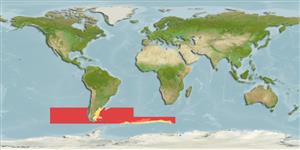Issue
This species is synonym of Bathylagus antarcticus Günther, 1878 in Eschmeyer (CofF ver. May 2011: Ref. 86870) following Kobyliansky (2006: Ref. 57776). The species page will be removed.
Environment: milieu / climate zone / depth range / distribution range
Ecologia
marinhas batipelágico; intervalo de profundidade 0 - 2800 m (Ref. 58018). Deep-water; 39°S - 58°S
Southern Ocean: Scotia Sea. Also known from the southwest Atlantic and southeast Pacific.
Tamanho / Peso / Idade
Maturity: Lm ? range ? - ? cm
Max length : 21.7 cm SL macho/indeterminado; (Ref. 5002)
Ciclo de vida ou comportamento de acasalamento
Maturities | Reprodução | Spawnings | Egg(s) | Fecundities | Larvas
Gon, O., 1990. Bathylagidae. p. 107-110. In O. Gon and P.C. Heemstra (eds.) Fishes of the Southern Ocean. J.L.B. Smith Institute of Ichthyology, Grahamstown, South Africa. 462 p. (Ref. 5002)
Status na Lista Vermelha da UICN (Ref. 130435)
Ameaça para os humanos
Harmless
Uso pelos humanos
Pescarias: sem interesse
Ferramentas
Relatórios especiais
Baixar XML
Fontes da internet
Estimates based on models
Preferred temperature (Ref.
123201): 1.9 - 4.8, mean 3.1 °C (based on 108 cells).
Índice de diversidade filogenética (Ref.
82804): PD
50 = 0.5078 [Uniqueness, from 0.5 = low to 2.0 = high].
Bayesian length-weight: a=0.00513 (0.00205 - 0.01282), b=3.00 (2.79 - 3.21), in cm total length, based on LWR estimates for this (Sub)family-body shape (Ref.
93245).
Nível Trófico (Ref.
69278): 3.2 ±0.39 se; based on food items.
Resiliência (Ref.
120179): médio(a), tempo mínimo de duplicação da população 1,4 - 4,4 anos (Preliminary K or Fecundity.).
Fishing Vulnerability (Ref.
59153): Low vulnerability (16 of 100).
